17. Inappropriate Coalitions - RonaldMah
Ronald Mah, M.A., Ph.D.

Licensed Marriage & Family Therapist,
Consultant/Trainer/Author
Main menu:
17. Inappropriate Coalitions
Therapist Resources > Therapy Books > Roles Rigidity Repair in Relationships
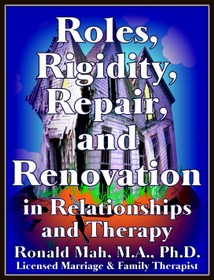
Roles, Rigidity, Repair, and Renovation in Relationships and Therapy
Chapter 17: INAPPROPRIATE COALITIONS
by Ronald Mah

Systemic theories assert that each family will seek balance even if it means doing so in a dysfunctional manner. The bond between one parent and child and between the same child and the other parent create some power in the system. "The power on each side should be equivalent to the other. Haley (1969) contends that the relationships between unions become more energized particularly during conflicts and confrontations between the members" (Simadi et al., 2003, page 476). There are three major relevant unions in the family. The stable union situation can help parents avoid conflict with each other. Each parent allies in a "positive" relationship with the child.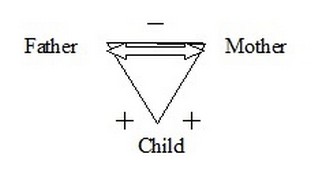
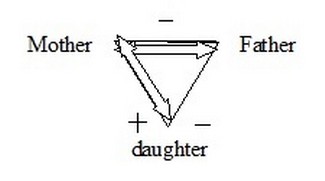
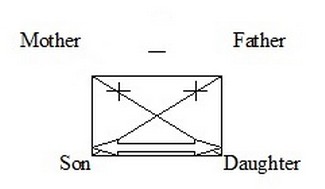
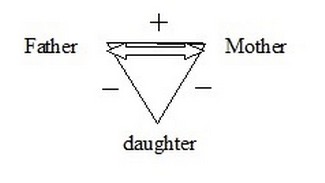

On the other hand, the child may suffer confusion about him or herself reconciling existence in antagonistic coalitions and be split trying to be loyal to both parents. "A schizophrenic personality is an expected outcome of this kind of union (Batson et al., 1956; Haley, 1969). This person is suffering from confusion and lack of insight". The child may be drawn or recruited to be a go between or pseudo-therapist to help resolve conflicts between the parents. The child is at risk to develop psychosomatic syndromes and psychological problems (Simadi et al., 2003, page 476-77). The second type is an opposing union situation. This occurs when one of the parents is extremely dominating. The other partner is subdued and suppressed in order for the dominant partner to gain and keep superiority. The weak parent will seek a union with a child in reaction to the oppressive relationship with the partner. This creates equilibrium between parents- for example, the figure below shows a mother-wife aligned with the daughter in the face of a tyrannical father-husband.

The relationship between the father and daughter is likely to become negative. The father become emotionally and psychologically isolated. This can make him likely to seek outside gratification for his needs. He may self-medicate or self-soothe with alcohol or drugs, gambling, affairs, or other dysfunctional behavior. The daughter or other child in this situation will suffer emotional and psychological damage as well from the relationships with both parents. One's father or parent who is the enemy of the "positive" parent becomes one's enemy as well. The attachment relationship with the supposedly positive parent will be unhealthy since it is not based on the proper hierarchy or role of parent-child but more of peer confidants. The "parents are psychologically divorced. In this case, if the family has a new child, the father or whichever parent is in the weak position would immediately unite with this child, and another union situation emerges" (Simadi et al., 2003, page 477). The following figure is shows a problematic family structure of spontaneous equilibrium.

All the relationships in this family are problematic, although there are ostensibly positive relationships between each parent and one child. The mother unites with the daughter to achieve balance within the family against the dominating power of the husband. In return, the husband forms a coalition with the son in order to maintain his authority. Interactions in this union may be seen in the following scenarios:
The mother may quarrel with the son due to his unacceptable behavior.The father may unite with the son to provide him with necessary protection.The daughter takes the mother's side in order to create a balance.The conflicts will increase between the two unions, thus the unions appear insufficient or dysfunctional.Two powers in these unions live in psychological isolation, and no situation would be comfortable to any member.In an attempt to unite the family, a child may opt for unacceptable behavior just to give life to the frozen feelings dominant in the family, for example, suicide attempts, engaging in streets fights or even joining a gang.After this event, the two parties live in a new interaction until one of them decides to escape from it in the future for whatever reason. (Simadi et al., 2003, page 478).
The figure below illustrates a strong spousal connection along with a failed relationship with a child who is somehow not acceptable. This can be a developmental deficit, mental or physical disability, or as in the case of some families or cultures, from disappointment that a male heir has not been produced.

This becomes a pathological union. The problem child or undesired child is the target for blame as a scapegoat. The problems of the relationship, couple, or family are seen as caused by the child's behaviors, issues, or existence. This serves to unify the parents as joint complainants, victims, or martyrs. The child may play out this role with pathological behaviors. Significant individual distress, personality problems, school and social failures (for example, isolation and a sense of rejection) can develop. The child may not be able to break into or challenge the parental/couple's coalition. Unable to get any positive validation or affection within the family, the child may look elsewhere (Simadi et al., 2003, page 479). The child may find support from other adults (teachers, coaches, extended family) or in a peer community. The therapist may find that children or teens brought to therapy because of behavior in a peer community exist in families with one or another of these dysfunctional coalitions or unions. The young family member may not be fully aware of his or her incorporation or compelled sacrifice for his or her parents' false unity. The child or teen may be well served if separated from the couple's dynamics. Therapy should at least carefully if not primarily address the couple's functioning versus focusing only on the child or teen issues.
Couples without children may present similar coalitions with friends, work, hobbies, problematic behaviors, alcohol, or drugs taking the place of the child as the third point in the triangle. The stable union situation where there is a negative relationship between the partners is comparable to a couple where both partners have a positive relationship with a common cause, such as a political or religious mission. The common cause could also be major financial or status benefit and/or stability. Such a couple may arrive in therapy after losing the unifying purpose or after achieving the common goal. This could be similar to the couple who has lost purpose after launching their last adult child. The opposing union situation with a dominating partner and weak partner where the weak partner recruits the child is comparable to a childless couple where the weak partner maintains an intimate relationship with a social group, hobby, or cause. As the dominating partner develops a negative relationship with the child in this union, he or she will come to think negatively or even hate the outside relationship the weaker partner creates- with his or her outside social philanthropy for example. The presenting issue in therapy may be the dominating partner complaining that the weaker partner spends too much time with "them" or "it," along with the weaker partner complaining that the dominating partner does not respect the importance of "them" or "it." Spontaneous equilibrium may be duplicated with each partner emotionally and physically invested in his or her own activity outside the relationship or household. They function in a parallel process due to the negative relationship between them. A stereotypical example would be the male being totally into his sports and tailgating with friends while the female is immersed in her gardening club activities and friends. False harmony is maintained through keeping their worlds separate. The pathological union with a positive couple's relationship founded upon joint animosity against the child may be comparable to a couple who connect together over a common enemy or adversary- the intrusive and snobby neighbors for example. Without the common antagonists, the couple may not find one another appealing anymore. A couple may bond as the two superior beings united on their personal Mt. Olympus to maintain their psychological and/or intellectual ascendancy over mere mortals. This could be a pair of narcissists functioning self-righteously as a power couple with every inferior else the third point of the triangle.

